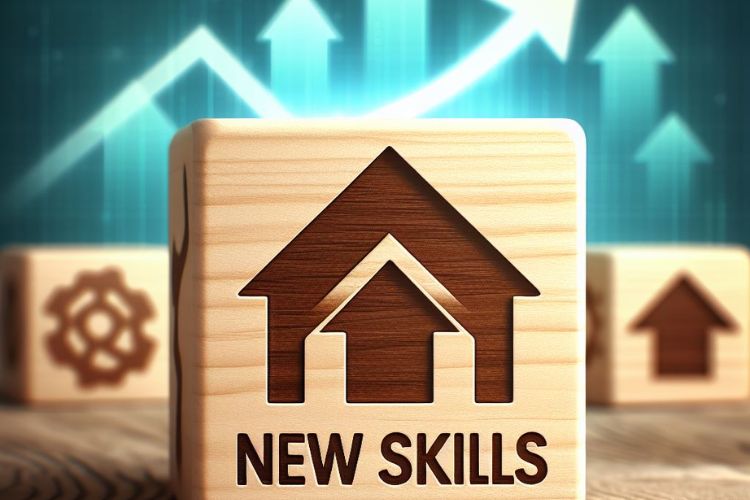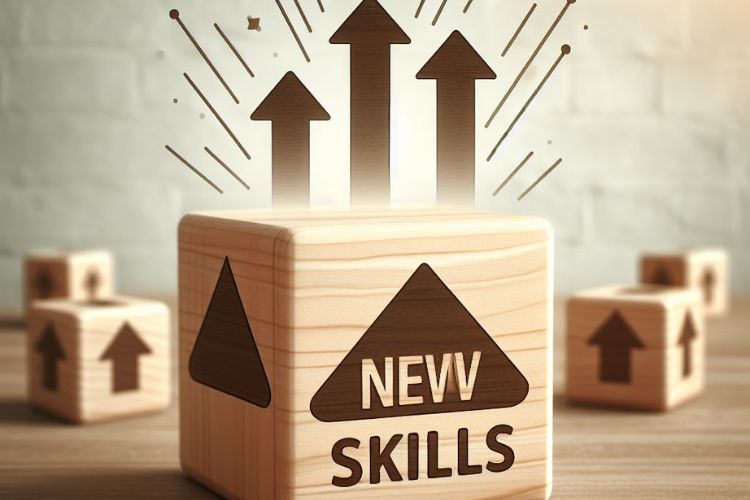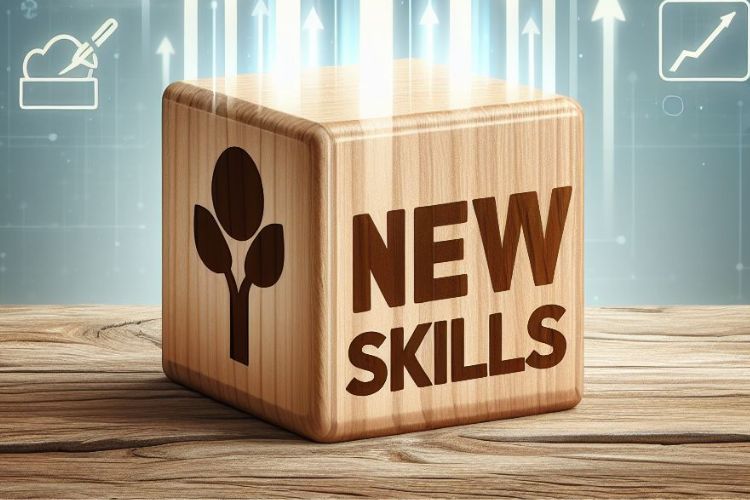The talent landscape is shifting. Automation and technological advancements have been constantly changing the skills needed to thrive in the workplace – as such, organizations that fail to adapt risk falling behind. This is where employee skill development comes in – not just as a feel-good initiative, but as a powerful tool for driving business success.
(by Jonathan M. Pham)
What is Employee Skill Development?
Employee skill development is the ongoing process of enhancing an individual’s expertise, know-how, and proficiencies within a professional context. It encompasses a continuum of learning experiences and initiatives designed to empower them with the requisite skills essential for optimal job performance, productivity, and career advancement.
In today’s rapidly evolving work landscape, where technological advancements and market dynamics continuously reshape job requirements, fostering a culture of ongoing improvement has become imperative for organizational success. This process goes beyond mere initial training; it involves a commitment to nurturing the workforce – by providing them with opportunities to acquire new competencies, refine existing ones, and adapt to emerging challenges.
Employee Skill Development Examples
There are a variety of areas that benefit from skill development – depending on the industry, job role, and individual needs. Below are some common examples across different domains:
Technical skills
- Software engineers: Engaging in continuous learning by mastering a new programming language or framework through avenues such as online courses, attending conferences, or participating in hackathons. This enables them to stay updated with the latest technologies and enhance their coding proficiency.
- Marketing specialists: Enhancing expertise by attending workshops focused on social media marketing strategies, data analysis, or search engine optimization. These sessions equip them with advanced techniques to optimize marketing campaigns and drive better results.
- Customer service representatives: Participating in role-playing exercises aimed at refining communication and conflict resolution skills. Through simulated scenarios, they may learn effective ways to handle customer interactions, leading to improved customer satisfaction.
- Project managers: Pursuing professional certifications like Project Management Professional (PMP) or undergoing training in Agile methodologies. These credentials validate their project management expertise and equip them with proven methodologies to ensure project success.
Read more: Agility Coaching – Navigating Change & Fueling Business Success
Soft skills
- Leaders: Enrolling in comprehensive leadership development programs tailored to enhance communication, delegation, problem-solving, and team-building skills.
- Sales representatives: Participating in targeted coaching sessions focused on refining negotiation and persuasion skills.
- Administrative assistants: Joining courses dedicated to project management and time management to enhance organizational skills, streamline workflows, and manage tasks more efficiently.
Cross-functional skills
- Accounting team: Gaining insights into marketing principles to understand how financial activities contribute to customer acquisition efforts.
- Product development team: Engaging in workshops on user experience design to create products that resonate with user needs and preferences.
- Sales team: Shadowing customer service representatives to gain firsthand insights into customer pain points and service expectations.
- Engineers: Empowering engineers with design thinking methodologies to develop user-centric solutions. By integrating user perspectives into the product development process, they may come up with products that deliver exceptional user experiences.
- Non-finance employees: Providing comprehensive training on company financials to employees from non-finance backgrounds. This initiative fosters a deeper understanding of financial metrics and encourages informed decision-making across departments.

Employee talent development
Business Case for Employee Skill Development
The workplace has been rapidly changing; as such, the imperative for continuous skill development has never been more pronounced. The World Economic Forum has predicted a significant shift in job requirements, with millions of new roles emerging alongside the automation of existing ones. To thrive amidst this transformation, businesses must recognize the strategic value of investing in their workforce.
As technologies evolve and job roles undergo transformation, individuals must constantly adapt to stay relevant. Businesses that proactively invest in development initiatives are better equipped to navigate change, drive innovation, and maintain a competitive edge in their respective industries. On the other hand, failure to address skill gaps will impede organizational agility and hinder progress, as highlighted by a McKinsey report indicating that a vast majority of organizations (up to 87%) are grappling with skill shortages.
Various studies have revealed a concerning trend wherein a significant portion of employees lack access to formal workplace training, relying instead on self-directed learning. This underscores the urgent need for businesses to prioritize skill development initiatives and provide structured learning opportunities for their workforce. Employees who perceive their organizations as invested in their professional growth are more likely to remain engaged and committed.
Notably, younger generations, such as millennials, place a premium on learning and development opportunities in the workplace. By fostering a culture of continuous learning, businesses can attract and retain top talent, nurturing a skilled workforce capable of driving organizational success.
In the aftermath of the COVID-19 pandemic, the importance of reskilling and upskilling has become even more pronounced. 64% of L&D professionals acknowledge the heightened priority of reskilling existing talent to address evolving skill gaps. Meanwhile, 72% of business leaders recognize the value of tailored learning programs aligned with strategic objectives, viewing them as catalysts for driving business growth and innovation.
Read more: Talent Transformation – Building a High-performing, Future-ready Workforce

The importance of employee skill development in the workplace
Benefits of Employee Skill Development
Employee skill development is a strategic investment that yields significant dividends for both individuals and organizations:
- Improved job performance
Equipping employees with the necessary skills enhances their ability to execute tasks effectively, leading to heightened job performance and productivity. Mastery of new skills instills confidence, enabling people to tackle challenges with greater efficiency and effectiveness.
- Increased engagement
Skill development initiatives foster a sense of fulfillment and progress, thereby boosting employee morale and making them more likely to be committed to their work.
- Career growth
Those equipped with a diverse skill set are better positioned to pursue upward mobility, find new opportunities (either within or without the organization), and navigate transitions in their career journey.
- Improved bottom line
A skilled workforce contributes to driving operational excellence, innovation, and efficiency – which translates into higher profits and better financial performance.
- Enhanced customer satisfaction
Employees with the requisite skills to address customer needs and resolve issues effectively contribute to improved customer experiences, driving repeat business and referrals.
- Reduced turnover
Organizations that invest in people development demonstrate a commitment to their workforce’s growth and well-being. This fosters loyalty and reduces turnover rates, resulting in cost savings associated with talent retention and attraction.
- Enhanced innovation and problem-solving
A skilled workforce is better equipped to innovate, think critically, and solve complex problems. Those with diverse skill sets bring fresh perspectives and ideas, driving innovation and maintaining competitiveness in the market.
- Greater adaptability & resilience
In today’s fast-paced and dynamic work environment, adaptability is essential for survival. Skillful employees can readily adapt to change, navigate challenges, and seize opportunities, thereby enhancing organizational resilience.
- Stronger teamwork & collaboration
Effective communication and interpersonal skills are vital for fostering teamwork and collaboration. Skill development initiatives that focus on enhancing these competencies contribute to a cohesive and high-performing team culture.
Investing in employee skill development fosters a culture of continuous learning and growth – in which everyone is motivated to never stop acquiring new knowledge and skills.
Developing the skills and competencies of employees not only benefits their current roles but also prepares them for future positions. Development initiatives lay the groundwork for succession management, ensuring a smooth transition and continuity of leadership within the organization.
Read more: Talent Management – Mastering the Basics for Success
Employee Skill Development Model & Theory
Various models and theories have been proposed to offer insights into the complex process of employee skill development, shedding light on the interplay between individual attributes, learning experiences, and environmental influences. Within this article, let us go through 3 influential frameworks:
Katz’s Three-Skill Approach
Katz’s model proposes that effective leadership hinges on three key skills: technical, human, and conceptual. Technical skills encompass specific knowledge and abilities required to perform tasks proficiently. Human skills pertain to the capacity to interact with and motivate others, fostering collaboration and teamwork. On the other hand, conceptual skills involve abstract thinking and strategic decision-making, crucial for navigating complex organizational challenges.
As such, the model underscores the multifaceted nature of leadership competence and emphasizes the importance of cultivating a diverse skill set.
Mumford et al.’s Skills Model
The Skills Model of Leadership identifies 5 components integral to skill development for those in management positions as follows:
- Individual attributes encompass innate traits such as cognitive ability, personality, and motivation, which shape one’s capacity for skill acquisition.
- Competencies represent the capabilities required for effective leadership, including problem-solving skills and social judgment.
- Leadership outcomes gauge the effectiveness of leadership based on problem-solving and social outcomes.
- Career experiences, such as challenging assignments and mentoring, provide opportunities for skill development.
- On the other hand, environmental influences, such as organizational culture and support, shape the learning context.
Dreyfus and Dreyfus’ Four-Stage Model of Skill Acquisition
This framework elucidates the progression from novice to expert in any domain, outlining four distinct stages:
- Novices exhibit limited understanding and rely on rigid rules and procedures.
- Advanced beginners start to grasp relevant aspects of the situation – but still rely heavily on guidance.
- Competent individuals demonstrate a sense of responsibility and are able to plan/ prioritize tasks effectively.
- Proficient learners possess a holistic understanding of the domain and can adapt their actions accordingly.
- Experts demonstrate deep, intuitive knowledge and excel in complex, unpredictable situations.
Dreyfus’ model highlights the iterative nature of skill development, emphasizing the importance of experience and practice in achieving expertise.
Read more: Instructional Design – Models, Principles & Strategies

Approaches to employee development
Types of Employee Skill Development
Employee skill development encompasses a diverse range of approaches tailored to meet the unique needs of organizations and their workforce. Here are various types of methods often utilized:
- Formal training
Formal training programs include traditional classroom sessions, online courses, and workshops conducted either internally or by external providers. These structured learning experiences offer comprehensive instruction on specific topics or skills relevant to one’s roles.
- On-the-job training
This method involves learning by performing tasks under the guidance and supervision of experienced colleagues. Thanks to its hands-on approach, team members are provided the chance to acquire practical skills in real-world scenarios, facilitating faster skill acquisition and application.
Mentorship programs pair employees with experienced mentors who provide guidance, advice, and support in skill development and career progression. The role of mentors is to offer insights, share knowledge, and serve as role models who contribute to the mentees’ professional growth and confidence.
Coaching entails working one-on-one with a coach to identify strengths, weaknesses, and development areas. Coaches can offer personalized guidance, feedback, and support to enable employees to enhance specific skills and visualize their professional goals.
- Internal knowledge-sharing sessions
These sessions are meant to allow employees to share their expertise and insights with colleagues across departments. As such, they help promote collaboration, foster a culture of continuous learning, and encourage the exchange of best practices within the organization.
- Upskilling/ reskilling programs
Upskilling and reskilling programs aim to equip employees with new competencies, often in response to technological advancements or evolving job requirements. These may include training on emerging technologies/ industry trends, or preparing team members for new roles within the organization.
- Tuition reimbursement
Tuition reimbursement programs provide financial assistance to employees pursuing further education, such as relevant courses, certifications, or degree programs. By investing in employees’ educational pursuits, organizations essentially play a critical role in supporting their continuous learning and skill development journey.
- Feedback & performance appraisal
Regular feedback and performance appraisal processes facilitate ongoing skill development by providing employees with constructive feedback on their performance, strengths, and areas for improvement.
- Self-directed learning
Self-directed learning empowers people to take initiative in acquiring new skills independently. This approach involves self-study through resources like books, articles, online tutorials, or educational videos, allowing one to customize their learning experience based on their interests and goals.
- Stretch assignments
Stretch assignments are challenging tasks or projects that push employees beyond their comfort zones and encourage skill development. These opportunities provide valuable learning experiences, allowing them to develop new competencies and expand their capabilities.
- Job shadowing
Job shadowing involves observing and learning from experienced colleagues by accompanying them in their day-to-day tasks. This firsthand exposure makes it easier to gain insights into different roles, processes, and responsibilities, thereby facilitating skill acquisition and career exploration.
- Simulation and gamification
Simulation and gamification techniques simulate real-life scenarios or incorporate game elements to engage employees in skill development activities. These interactive approaches provide a fun and immersive learning experience, allowing participants to practice skills, solve challenges, and receive instant feedback.
- Professional development conferences and events
Attending professional development conferences, seminars, or industry events exposes employees to new trends, technologies, and best practices. These networking opportunities and educational sessions foster learning, inspire innovation, and keep employees abreast of industry developments.
By leveraging a combination of diverse skill development methods and activities, organizations may deliver comprehensive and impactful learning experiences that empower individuals to thrive and contribute effectively in today’s dynamic work environment.
Employee Skill Development Stages
The process of skill development typically progresses through various levels – which have been explained by a variety of frameworks. Here, let us go over two prominent models:
The Dreyfus and Dreyfus Model
- Novice: Beginners with limited theoretical knowledge and practical experience. They rely on rules and instructions, may make many mistakes, and have difficulty understanding the context or the goal of the skill.
- Advanced beginner: Gaining some basic knowledge and practical experience. Able to apply rules in familiar situations – but still rely on rules and feedback to perform the skill. May have some success and confidence, but still face a lot of challenges and limitations.
- Competent: Able to perform independently but rely on past experiences and problem-solving strategies. Can plan & prioritize tasks, and take responsibility for one’s actions. Can perform the skill with consistency and efficiency, but still need some supervision and support.
- Proficient: More flexible and adaptable, able to handle unexpected situations and choose appropriate strategies.
- Expert: Operate intuitively and effortlessly, with deep understanding and automatic responses to complex situations. Can also train and mentor others. Can come up with new and innovative ways of doing the skill, but may also face some complacency and stagnation as a result of their expertise.
The Four Stages of Conscious Competence
Focuses on individual awareness and effort during skill development, this model is comprised of the following phases:
- Unconscious Incompetence: Unaware of lacking a skill or its importance.
- Conscious Incompetence: Becoming aware of a skill gap and its challenges.
- Conscious Competence: Deliberately practicing and learning, requiring focused effort and error correction.
- Unconscious Competence: Skill becomes automatic and effortless, performed intuitively with minimal attention.
Additionally, it also proposes a few influencing factors – including individual factors (e.g. learning style, motivation, prior knowledge, practice time), skill complexity, and learning environment (i.e. availability of resources, feedback, and support).

Key Employee Skills for the Modern Workplace
What skills should employees have? The modern workplace is constantly evolving, requiring people to possess a diverse set of capabilities to thrive. While specific needs vary across industries and roles, certain key competencies are universally sought after:
Core skills
- Communication: Proficient communication, encompassing written, verbal, and nonverbal forms, facilitates effective collaboration, information sharing, and relationship-building within teams and with stakeholders.
- Relationship building: The ability to cultivate trust, resolve conflicts, and foster positive relationships with colleagues, clients, and stakeholders is essential for teamwork and achieving organizational goals.
- Problem-solving & critical thinking: Being able to analyze complex situations, identify underlying issues, and devise innovative solutions is crucial for overcoming challenges and driving progress.
- Decision-making: Making informed decisions, weighing options, and taking calculated risks based on analysis and intuition contribute to effective leadership and problem-solving.
- Adaptability & flexibility: Embracing change, learning new technologies and processes, and quickly adapting to evolving circumstances are hallmarks of resilience in the modern workplace.
- Collaboration & teamwork: Working collaboratively in diverse teams, sharing knowledge, delegating tasks, and fostering a culture of mutual support are essential for achieving collective success.
- Virtual collaboration: Effectively leveraging digital tools and communication platforms to collaborate seamlessly with remote colleagues and clients has been becoming increasingly important in dispersed work environments.
- Time management & organization: Efficiently managing priorities, setting deadlines, and optimizing workflow contribute to individual and team productivity.
Digital skills
- Digital literacy: Fundamental understanding of technology concepts, proficient use of communication tools, and navigating digital platforms are prerequisites for effective work in digital environments.
- Data analysis & interpretation: Proficiency in collecting, analyzing, and interpreting data enables informed decision-making and drives organizational insights.
- Cybersecurity awareness: Understanding online threats, adhering to cybersecurity protocols, and safeguarding data and systems are critical in safeguarding against online risks.
- Social media proficiency: Leveraging social media for communication, marketing, or research purposes enhances organizational visibility and engagement in the digital sphere.
Read more: Human Leadership in a Digital World – Skills & Strategies for Sustainable Success
Additional desirable skills across other development areas
- Creativity & innovation: Cultivating a creative mindset, generating novel ideas, and fostering innovation contribute to competitive advantage and organizational growth.
- Emotional intelligence (EQ): Self-awareness, empathy, and effective management of emotions enhance interpersonal relationships and leadership effectiveness.
- Learning agility: The ability to rapidly acquire new knowledge and skills, particularly in fast-paced environments, fosters adaptability and resilience amidst change.
- Lifelong learning: Embracing a mindset of continuous learning and skill development ensures relevance and longevity in one’s career trajectory.
- Intercultural awareness: Understanding and valuing diverse cultures and perspectives promotes inclusive and collaborative work environments in a globalized workforce.
- Self-leadership: Taking initiative, setting goals, and proactively driving personal and professional growth demonstrate resilience and commitment to excellence.
Read more: 10 Learning & Development Trends to Help Your Workforce Thrive

Employability skills
How to Develop Employee Skills
Developing employee skills involves a strategic approach aimed at aligning individual development with organizational objectives. Here’s a comprehensive step-by-step guide:
- Conduct Training Needs Analysis
Begin by assessing the current skill levels of employees and identifying any gaps between existing competencies and job requirements. Consider future organizational goals and industry trends as well to better anticipate future needs. During this process, one may utilize various assessment tools such as surveys, performance evaluations, and skills assessments to gather relevant data.
- Choose the right development methods
Select approaches that cater to diverse learning styles and preferences. Organizations should offer a mix of formal training programs, on-the-job experiences, mentorship opportunities, and online courses to accommodate varying learning preferences.
- Develop a comprehensive plan
Create a detailed plan outlining the specific skills to be developed, the methods and resources allocated for training, and the expected outcomes. Define clear objectives and key performance indicators (KPIs) to measure the success of the program. Establish a budget and allocate resources accordingly to ensure the effective implementation of the initiative.
- Secure buy-in from employees
The next step is to communicate the benefits of skill development programs to employees to gain their support and participation. Organizations must emphasize how acquiring new competencies will contribute to their professional growth, job satisfaction, and career advancement. Encourage active engagement and involvement in the development process to foster ownership and commitment.
- Measure results & make adjustments
Regularly track the progress of skill development initiatives and evaluate their effectiveness against predefined KPIs. Solicit feedback from participants to identify areas for improvement and make necessary adjustments to the program. Continuously monitor the impact of such efforts on individual performance and organizational goals, refining strategies as needed to optimize outcomes.

Steps required for skill enhancement and employee development at work
Read more: Future Ready Organization – 11 Tips to Building One Capable of Adapting to Industry Trends
How to Measure Employee Skill Development
Measuring employee skill development requires a systematic approach that aligns with organizational goals and encompasses both quantitative and qualitative metrics:
- Define goals & metrics
Begin by clearly identifying the objectives of your skill development initiatives. List down the specific skills you aim to enhance, considering both technical proficiencies and soft ones. Determine the level of improvement expected and set measurable goals to track progress effectively.
- Link to business impact
Ensure that the chosen metrics are aligned with broader business objectives. Establish connections between improved skills and tangible business outcomes such as increased revenue, cost reduction, enhanced customer satisfaction, or improved employee retention. Being able to demonstrate the direct impact of development initiatives on organizational success enhances their perceived value and justifies the investment.
- Perform skill assessment
Assessments provide objective data on skill proficiency and highlight areas for improvement. Various methods may be adopted to evaluate employee skills accurately. You can consider formal standardized tests, skills assessments tailored to specific job roles, or project-based evaluations that simulate real-world challenges.
- Utilize multiple measurement methods
No single measurement method can capture the complexity of skill development comprehensively. As such, one should aim to employ a combination of quantitative metrics – such as performance metrics and certification completion rates – and qualitative measures, including feedback from supervisors, peers, and self-assessment. Observing behavior changes and conducting surveys or interviews can offer valuable insights into the progress.
- Consider the timeframe and impact
Skill development is a gradual process that only unfolds over time. As such, we must set realistic expectations and track progress over defined intervals, such as quarterly or annually. Evaluate the long-term impact of such initiatives on individual performance, team dynamics, and organizational objectives. Assessing both short-term improvements and sustained progress provides a comprehensive understanding of the effectiveness of the efforts.
Employee Skill Development Best Practices
- Facilitate lateral movement: Encourage employees to explore lateral movement within the organization, so that they may gain exposure to diverse roles, departments, and projects. This fosters cross-functional collaboration, broadens skill sets, and promotes a holistic understanding of the business.
- Implement job rotation & cross-training: Consider introducing job rotation and cross-training initiatives to expose team members to various tasks and responsibilities. This approach enhances versatility, adaptability, and resilience, enabling people to tackle evolving work demands with confidence.
- Offer personalized training programs: Provide a diverse range of personal and technical training programs tailored to individual needs and career aspirations. Consider flexible learning options such as online courses, workshops, and certifications to accommodate diverse learning preferences and schedules.
- Unlock creativity: Organizations should build up a culture that nurtures innovation. Encourage brainstorming, experimentation, and risk-taking to stimulate creative thinking and problem-solving skills. Provide platforms for collaboration and idea-sharing to harness the collective creativity of teams.
- Foster a goal-oriented mindset: Promote a goal-oriented mindset by aligning personal and organizational objectives. Encourage goal setting, progress tracking, and milestone celebrations to instill motivation, focus, and accountability in skill development endeavors.
- Cultivate a learning culture: Promote a culture of continuous learning and coaching within the organization. Encourage employees to set learning goals, share knowledge, and recognize achievements in skill development. Provide dedicated resources, time, and incentives to support learning activities and foster a growth mindset.
- Make learning accessible and engaging: Ensure accessibility to training resources for all employees, regardless of location or job title. Incorporate gamification elements and interactive platforms to make learning engaging and enjoyable. Additionally, encourage collaboration and peer-to-peer learning through online forums, communities, and group projects.
- Partner with external providers: In certain cases, organizations may want to collaborate with external training providers, universities, and professional associations to offer specialized training programs. Leveraging external expertise not only supplements internal initiatives – but also exposes employees to diverse learning opportunities.
- Invest in leadership development: It is critical to equip leaders with coaching, mentoring, and motivational skills to support employee skill development initiatives effectively. Strong leadership fosters a supportive learning environment and empowers employees to reach their full potential – while weak leadership does just the exact opposite.
- Utilize technology: Harness the power of technology to facilitate skill development initiatives. Implement learning management systems, online collaboration tools, and mobile learning apps to deliver training content efficiently and enhance accessibility for employees.
Sample Template for Designing an Employee Skill Development Plan
Employee: John Smith
Role: Marketing Specialist
Department: Marketing & Communications
1. Identify Development Needs:
- Through performance reviews: John consistently exceeds expectations with marketing campaigns but struggles with data analysis and reporting.
- Self-assessment: John expresses interest in learning data analysis to gain deeper insights into campaign performance.
2. Set SMART Goals:
- Specific: John will learn basic data analysis techniques using Google Analytics.
- Measurable: He will complete an online course and achieve a score of 80% on the final exam.
- Achievable: The course is beginner-friendly and aligns with his available time and resources.
- Relevant: Data analysis skills will directly improve his campaign reporting and contribute to marketing goals.
- Time-bound: He will complete the course and achieve the target score within 3 months.
3. Choose Development Activities:
- Online course: “Introduction to Data Analysis with Google Analytics” (10 weeks)
- Mentorship: Partner with a data analyst in the company for weekly insights and guidance.
- Shadowing: Observe the data analyst for a day to gain practical understanding.
4. Develop an Action Plan:
| Activity | Timeline | Resources |
Success Measures
|
| Enroll in online course | Week 1 | Course fee, Learning Management System |
Completion certificate, exam score
|
| Schedule weekly meetings with mentor | Weeks 2-10 | Mentor’s time, communication platform |
Feedback, guidance on practical application
|
| Shadow data analyst | Week 5 | Data analyst’s availability, observation checklist |
Understanding of workflow, data analysis tasks
|
| Apply learnings to current project | Weeks 8-10 | Project data, reporting tools |
Improved data integration in reports, insightful presentations
|
5. Monitor and Evaluate:
- Regular check-ins: Discuss progress with John, mentor, and manager.
- Mid-term review: Assess progress towards goals and adjust the plan if needed.
- Final evaluation: Analyze course completion, exam score, mentor feedback, and application of skills in project reports.
Employee Skill Development Tools
When it comes to employee skill development, there is a wide range of tools available to choose from. The best ones will depend on one’s specific needs, budget, and employee preferences. Here are some popular options categorized by their function:
Learning Management Systems (LMS):
- Centralized platforms for delivering, managing, and tracking training content.
- Offer features like course libraries, learning paths, progress tracking, and reporting.
- Examples: Cornerstone OnDemand, TalentLMS, SAP Litmos.
Learning Experience Platforms (LXP):
- Modern LMS that offer personalized learning experiences, social learning features, and microlearning content.
- Focus on engagement and knowledge sharing.
- Examples: Degreed, EdApp, 360Learning.
Authoring Tools:
- Create custom eLearning courses, videos, and assessments.
- Cater to diverse learning styles and content needs.
- Examples: Adobe Captivate, Articulate Rise, Elucidate.
Microlearning Platforms:
- Offer bite-sized learning modules focused on specific skills or tasks.
- Convenient for busy employees and on-the-go learning.
- Examples: GoFormative, Teachable, Podia.
Performance Management Software:
- Integrates skills development with performance reviews and goal setting.
- Allows for personalized development plans and tracking progress.
- Examples: BambooHR, Workday, Zoho Performance Management.
Mentorship Platforms:
- Connect employees with mentors inside or outside the organization.
- Facilitate knowledge sharing, career guidance, and skill development.
- Examples: MentorCruise, MentorHub, Lunch & Learn.
Gamification Platforms:
- Use game mechanics like points, badges, and leaderboards to motivate learning.
- Increase engagement and make learning fun.
- Examples: Axonify, Bunchball, G-Pact.
Social Learning Platforms:
- Facilitate knowledge sharing and collaboration among employees.
- Encourage peer-to-peer learning and community building.
- Examples: Yammer, Workplace by Meta, Slack.
Virtual Reality (VR) and Augmented Reality (AR) Training:
- Immersive simulations for skills development, particularly in technical fields.
- Provides realistic experiences and enhances engagement.
- Examples: STRIVR, Talespin, ARKit (Apple).
Read more: Enhancing Team Productivity with the Right Software

How ITD World Can Help With Employee Skill Development
In today’s dynamic business landscape, where new technologies and trends emerge daily, simply having talented individuals isn’t enough. What you need is a strategically developed workforce, equipped with relevant and evolving skillsets to stay ahead of the curve.
That’s where ITD World comes in. As a global leader in talent and leadership development, we offer a comprehensive suite of solutions tailored to uplift your employees’ skill development and elevate your organization’s performance.
Identifying skill gaps and development needs
Our journey begins with a thorough understanding of your unique needs. Through rigorous analyses, evaluations, and consultations, we work closely with you to identify critical skill gaps within your workforce, aligning them with your strategic goals and objectives. Whether it’s leadership development, soft skills enhancement, or industry-specific technical expertise, we pinpoint the areas where your employees need to grow.
Curating personalized learning experiences
We design individualized learning paths, taking into account your team members’ current skill level, career aspirations, and preferred learning styles. This could involve a blend of:
- Interactive online courses from our extensive library of globally recognized partners.
- Immersive classroom training led by our team of renowned industry experts and coaches.
- On-the-job mentoring programs that connect people with experienced veterans who will share their wisdom and guide others’ development.
- Challenging stretch assignments to push people outside their comfort zones and unlock their full potential.
Delivering engaging learning solutions
Our trainers and learning consultants are passionate about creating interactive learning experiences that go beyond rote memorization. We utilize innovative instructional techniques, cutting-edge tools, and real-world scenarios to ensure knowledge retention and skill transferability. Whether it’s collaborative workshops or gamified learning modules, we keep your employees actively involved and motivated throughout their development journey.
Measuring and tracking progress
We don’t just stop at delivering programs. We continuously monitor and measure the impact of our interventions, providing you with quantitative data and objective feedback on how your employees are progressing. This allows us to fine-tune the learning paths and ensure they are effectively addressing your organization’s evolving needs.
Fostering a culture of continuous learning
Building a sustainable learning culture is key to achieving long-term success. We work with you to create an environment that encourages knowledge sharing, peer-to-peer learning, and lifelong development. This could involve launching internal knowledge-sharing platforms, organizing regular learning events, and recognizing and rewarding employees who actively participate in their own skill development journey.
Partnering with ITD World is an investment in your people and your future. We are dedicated to helping you cultivate a highly-skilled, engaged, and future-proof workforce that drives innovation, accelerates growth, and empowers your organization to thrive in the ever-changing global landscape.
Take the first step towards transforming your workforce today. Contact us to discuss your specific needs and discover how we can help you unlock the full potential of your employees!
Other resources you might be interested in:
- Human Resource Management: Key Foundations
- Talent Philosophy: A Guide to Unlocking Workforce Potential & Driving Success
- Organization Development (OD): A Closer Look
- Train the Trainer Model: Investing in Excellence
- HR Business Partner (HRBP): Bridging HR & Business for Remarkable Results

